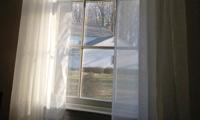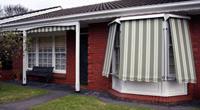Emergencies and IAQ
Información disponible en español
Preparation and response to weather-related and man-made emergencies is particularly important when it comes to indoor environments, since humans spend most of their time indoors, and rely on indoor spaces for shelter. Educating yourself about how to prepare for and respond to weather-related and man-made emergencies that affect indoor environments can help protect you and your family by preserving healthy indoor air quality.
On this page:
On other pages:
- Flood Cleanup to Protect Indoor Air Quality
- Wildfires and Indoor Air Quality (IAQ)
- Create a Clean Room to Protect Indoor Air Quality During a Wildfire
- Homeland Security and the Indoor Environment
- EPA's comprehensive information page on Natural Disasters
General Tips
- Have a battery-powered radio to keep you informed and prepared for approaching severe weather conditions in your local area and have access to a telephone in case of emergency.
- Listen to state and local public health agencies public service announcements (PSAs) or news releases advising the public on how to protect your health and prepare your home in the event severe weather conditions.
- If possible, identify emergency shelters in advance. If your home is without electric power for a sustained period of time, you may want to make arrangements to stay in an emergency shelter or other alternate location if practical.
Power Outages
Increasingly, homes and buildings in the U.S. are designed and built to maintain comfortable and healthy indoor environments, regardless of what the weather is like outside. Most homes and buildings rely on electrical power to help keep indoor conditions acceptable to the people inside. Power outages that last longer than a few hours often caused by extreme weather events, like storms or flooding, can have negative impacts on indoor environments. For example, without electricity, controlling the temperature indoors may be difficult or impossible, and if the ventilation system in the home or building doesn't work without power, the amount of pollutants inside could increase. However, in many cases, steps can be taken to help maintain indoor air quality without the use of electricity.
Install Carbon Monoxide (CO) Alarms to Prevent CO Poisoning
Carbon monoxide (CO), which is an invisible and odorless gas, can come from a variety of combustion appliances, like gas stoves, ovens or barbeque grills. CO can build up quickly indoors and can linger for hours and at elevated levels can cause significant harm and even death. Make sure that your home is equipped with CO alarm(s), and that alarm(s) are properly calibrated when installed and have a digital display and battery backup function. The U.S. Consumer Product Safety Commission (CPSC) recommends that every home have CO alarms on each level outside each sleeping area. CO alarms are available at most hardware stores.
Open and close windows and use window coverings such as drapes, shades and awnings to help moderate indoor air temperature. When windows are open, screens may be used to prevent pests from entering the home. Keep in mind that the security of your home may also be a consideration when windows are open.
If you are unable to open your windows, it may be possible to get enough ventilation by opening your doors. If not, you may need to relocate.
Learn about Carbon Monoxide's Impact on Indoor Air Quality
Ventilation and Shading Can Help Control Indoor Temperatures
In Warm or Hot Conditions:
During the day in warm or hot conditions, cover windows that receive morning and afternoon sun with shades to reduce the amount that indoor air temperatures rise. You can use drapes, shades, roller shades, awnings or louvers to cover your windows. Outdoor awnings and louvers can reduce the heat that enters a home more than indoor shades. In general, if the air outside is hotter than the air inside, close the windows. If the air outside is cooler, open the shades or drapes, and the windows.
In Cool or Cold Conditions:
Open drapes and window shades during the day to help warm the indoor air and close them at night to help retain the heat. In general, leave the windows closed if the air outside is colder than the air inside.
Indoor Air and Ventilation in Extreme Temperature Situations: Although keeping windows and doors closed may help maintain temperatures, in some cases it may be necessary to open the windows slightly to maintain adequate ventilation. Note that some amount of air movement or infiltration (passive ventilation) occurs naturally, as air passes through small openings or cracks, windows and doors, so there is always some small amount of ventilation. This small amount of ventilation, however, may not be enough to maintain adequate ventilation in extreme temperature situations.
Safely Provide Power for Lighting, Cooking and Heating

Portable Generators: During power outages, portable generators can be used to help temporarily restore power to a few key appliances such as refrigerators, lights and fans. Portable generators that use fuels such as gasoline, natural gas or kerosene are widely available. However, if they are not used correctly they can be hazardous because these generators give off toxic fumes.
- Use portable generators outside and far away from buildings.
- Do not use portable generators inside your house or garage. Do not put portable generators on balconies or near doors, vents or windows. Do not use portable generators near where you or your children are sleeping.

Rechargeable Power Sources: Rechargeable solar powered generators/batteries are also available to use during a power outage. In some areas this may be a practical choice to power small appliances. In general, they are less powerful than fuel powered portable generators, and provide back-up power for a shorter period of time.
Heating: During a power outage, do not try to heat your home by using combustion appliances including gas stoves or ovens, barbeque grills or dryers. never operate any gas-burning heater or other appliance in a poorly vented or closed room, or where you are sleeping.
Cooking: Do not use barbecues, hibachis, camp stoves, or any other non-vented combustion appliances to cook indoors, or for any other indoor use. Combustion appliances produce toxic fumes, including carbon monoxide (CO). While you shouldn't use any kind of combustion appliance, there are ways to cook indoors during a power outage. You can use a vented fireplace or a vented wood or other fuel burning stove, if it is set up for cooking.
Lighting: Use flashlights or batter powered lanterns if available. If you use candles, make sure the area is ventilated since candles emit combustion products and, if left unattended, can be a fire hazard. If available, use flashlights or battery powered lanterns instead of candles.
Natural Disaster References
Dust Storms
- Victoria Australia - Dust Storms Health Effects Exit
- State of New Mexico Dept. of Health - Dust Storms and Health (PDF) (1 pp, 39 K, About PDF) Exit
Wildfires and Agricultural Fires
- The AIRNow website
- The U.S. EPA, NOAA, NPS, tribal, state and local agencies developed the AIRNow website to provide the public with easy access to national air quality information. The website offers daily Air Quality Index (AQI) forecasts as well as real-time AQI conditions for over 300 cities across the US, and provides links to more detailed State and local air quality websites.
- Outdoor Air Quality & Visibility Indices
- Federal Air Quality Index (AQI) Basics
- EPA AQI Map
- State of Montana Department of Environmental Quality - Fire Updates Exit
- State of Colorado - Wildfire Information Exit
- State of Washington - Air Quality Advisory (PDF) (1 page, 42 K) Exit
- U.S. Dept. of Agriculture - Visibility Indices - Bitterroot, 2000, Wildfire Smoke (PDF) (6 pp, 79 K)Exit
- AIRNow - Fires and Your Health
- American Red Cross - Wild Fire Safety Checklist (PDF) (1 page, 257 K) Exit
- EPA - Particle Pollution Brochure (2003) (PDF) (2 pp, 318 K)
- EPA - How Smoke from Wildfires Can Affect Your Health
- State of California Air Resources Board - Wildfire Smoke Guide (2008) (PDF) (53 pp, 1.35 M) Exit
- CDC
- Wildfires
- CDC Blog (November 2011): Wildfires: What You Need to Know
Volcanic Eruptions
- CDC - Key Facts About Protecting Yourself During a Volcanic Eruption Exit
- The International Volcanic Health Hazard Network (pamphlets) Exit
Supply Kit Recommendations
- Centers for Disease Control and Prevention (CDC) - Supply Kit Recommendations Exit
- American Red Cross - Supply Kit Recommendations Exit
- Occupational Safety and Health Administration (OSHA) - Emergency Preparedness Exit
General
- U.S. Dept. of Homeland Security: Federal Emergency Management Agency (FEMA) portal to Disaster Events Exit
- U.S. EPA: Natural Disasters
- Centers for Disease Control and Prevention (CDC): Emergency Preparedness Information
- American Red Cross Exit
- Occupational Safety and Health Administration (OSHA) - Emergency Prepardness Exit
- Particulate Respirators (including N-95 respirators
CDC - NIOSH-Approved Particulate Filtering Facepiece Repirators
Additional Resources
- CDC's Heat-Related Illnesses Fact Sheet Exit
- CDC's Carbon Monoxide Poisoning Fact Sheet Exit
- CPSC's Generators & Engine-Driven Tools page (includes Portable Generators) Exit
- EPA's Burnwise: Best Practices for Burning - Follow best burn practices when using a fireplace; use battery powered smoke alarm.
- EPA's Carbon Monoxide information page.
- FEMA's Ready.gov Power Outages: More on what you can do before, during and after a power outage. Exit



